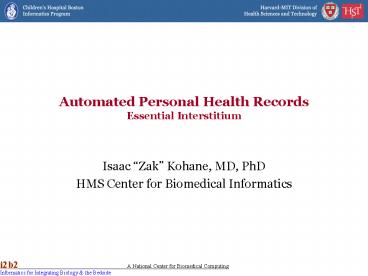Automated Personal Health Records Essential Interstitium - PowerPoint PPT Presentation
1 / 42
Title:
Automated Personal Health Records Essential Interstitium
Description:
Relative Underperformance of the Healthcare and Biomedical Research System. Genetics As Destiny ... The constitutionality of DNA sampling on arrest. ... – PowerPoint PPT presentation
Number of Views:51
Avg rating:3.0/5.0
Title: Automated Personal Health Records Essential Interstitium
1
Automated Personal Health RecordsEssential
Interstitium
- Isaac Zak Kohane, MD, PhD
- HMS Center for Biomedical Informatics
2
Drivers
- Genetics Genome-scale Measurements
- Relative Underperformance of the Healthcare and
Biomedical Research System
3
Genetics As Destiny
4
(No Transcript)
5
Prismatic Example PPARg Pro12Ala and diabetes
Oh et al.
Deeb et al.
Mancini et al.
Clement et al.
Hegele et al.
Hasstedt et al.
Lei et al.
Ringel et al.
Sample size
Hara et al.
Overall P value 2 x 10-7 Odds ratio 0.79
(0.72-0.86)
Meirhaeghe et al.
Douglas et al.
Altshuler et al.
Mori et al.
All studies
Estimated risk (Ala allele)
0.2
0.4
0.6
0.8
1
1.2
2.0
1.4
1.6
1.8
0.1
0.3
0.5
0.7
0.9
1.1
1.3
1.5
1.7
1.9
Ala is protective
Courtesy J. Hirschhorn
6
Compared to what?
- Relative Risk Rexp/Rcontrol
7
(No Transcript)
8
Concerns of Identifiability
- 1010 humans living
- Unrelated humans 99.9 genetically alike
- How many SNPs to identify you?
Lin et al.
9
Failure 1
10
- Failure 2 No Life-long medical record
- Highly mobile patients
- No formalized data exchange
X
X
11
A Fraught Solution 1994
12
A Fraught Solution 2005
13
Not the Solution
Tethered PHR
14
Solution Instance PING
- Personal Internetworked Notary and Guardian
- Personally controlled records
- Ubiquitous
- Open standards
- Open source
- Web interface
- Public key infrastructure
- XML-based data
15
PCHR-centric (Aristotelian)
16
(No Transcript)
17
(No Transcript)
18
(No Transcript)
19
(No Transcript)
20
(No Transcript)
21
(No Transcript)
22
(No Transcript)
23
(No Transcript)
24
(No Transcript)
25
(No Transcript)
26
(No Transcript)
27
- Indiana screenshot and photo here.
28
Our Watson, come here I need you moment
29
(No Transcript)
30
But is this sufficient?
- Can we invert the now traditional relationship
between patient and researcher? - Do all countries worry as much about privacy?
- Do patients prefer to disclose to their doctor
more than their family? - Are all individuals equally comfortable with
personal disclosure?
31
Information Exhibitionism or Altruism?
32
A 3-part Solution
33
Legislation
Selectable Disclosure
Information Altruism
34
(No Transcript)
35
Information Opportunim
- Who literally profits from patient data?
- 18K/annum per patient for doctors?
- Should patients?
- How can we reimagine the patient-research
relationship? - Turning liability and risk into opportunity
36
Our patients and our biomedical research goals at
risk
- Jill Genomus is a genomic researcher studying
Autism Spectrum Disorder (ASD). In a
high-resolution genome-wide scan and
transcriptome-wide profiling of the patients in
her anonymized database, she has two particular
findings that appear to require follow-up. The
first is the incidental finding in two siblings
in one family that reveal a segmental chromosomal
duplication that puts them at very high risk for
colon cancer. The second is a single nucleotide
polymorphism that is present in five children
affected with ASD and no others. - Jill has a pang of anxiety when she realizes that
she does not know who any of these individuals
are and furthermore is proscribed by the
Institutional Review Board (IRB) protocol that
was approved for this study from re-contacting
any study subject.
37
The Informed Cohort
38
(No Transcript)
39
(No Transcript)
40
Applications
- Gathering of genomically informed adverse events
DURING phase III trials and into phase IV. - Public Health alerts that are targeted only to
individuals at genetic and environmental personal
risk. - Recruitment of patients without conflict of
interest from recruiting physicians.
41
The Electronic Medical Record will fail without
broad implementation of PCHR
- To make it feasible to achieve large N
- To make the EHR truly lifelong
- To harness patients activation as consumers
- To overcome privacy concerns and leverage
volunteerism - To overcome stark knowledge and time deficits in
the interaction between patients and healthcare
system.
42
Welcome to our brave new world!
- Thank you.
43
What does this alarming calculation presume?
The constitutionality of DNA sampling on
arrest. Cornell Journal of Law and Public Policy,
June, 2001 by Kaye, D.H. INTRODUCTION Every
state now collects DNA from people convicted of
certain offenses. (1) Law enforcement authorities
promote offender DNA databanking on the theory
that it will clear previously unsolved crimes and
identify offenders who commit additional crimes
while on probation or parole, or after they have
finished serving their sentences. Even relatively
small databases have yielded such dividends. (2)
As these database searches uncover the
perpetrators of rapes, murders, and other
offenses, the pressure builds to expand the
coverage of the databases. (3) As the databanks ..
44
Peer Pressure
The men of Wee Waa































